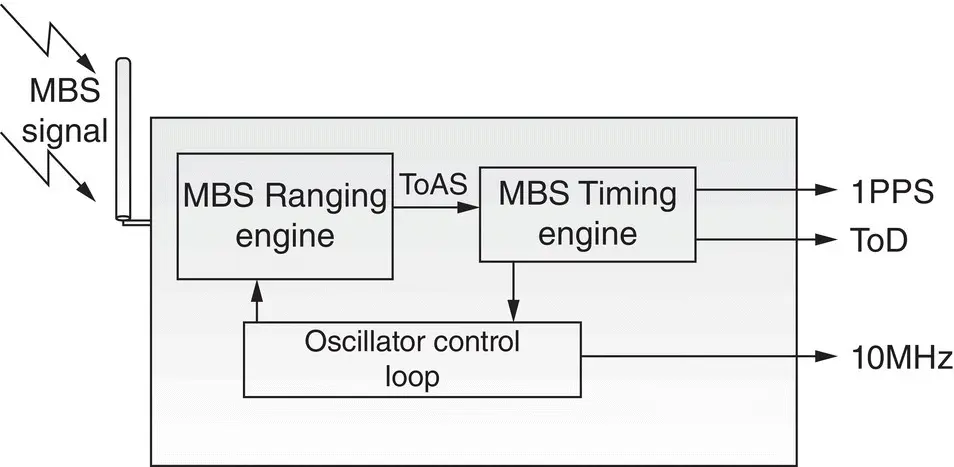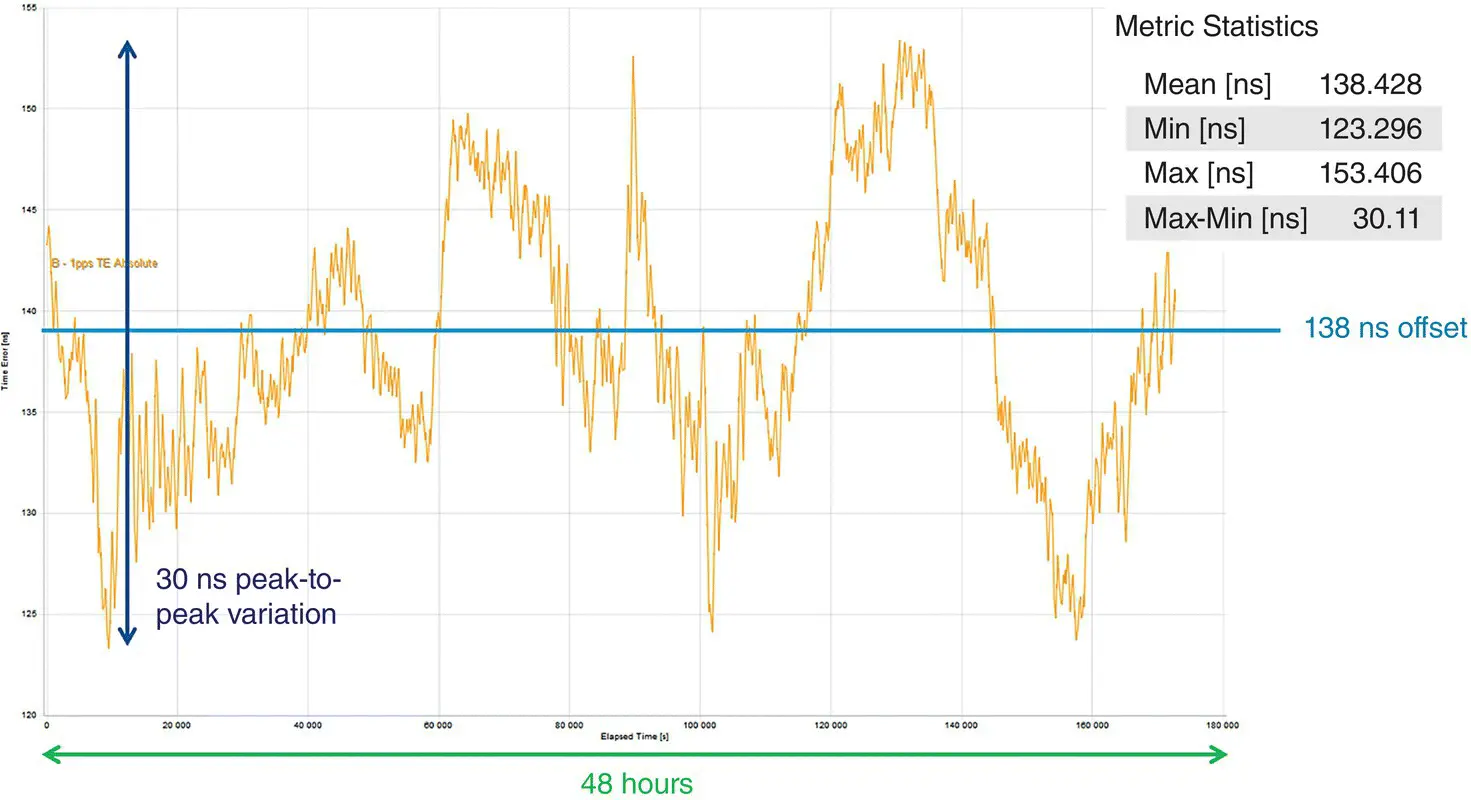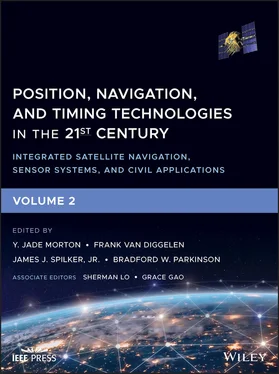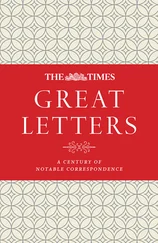39.1.5 Assisted Mode of MBS
The Assisted GPS (A‐GPS) concept was developed to improve the sensitivity and time to fix of a GPS receiver when compared to a stand‐alone GPS receiver. See [10] for an explanation of the A‐GPS concept. A‐GPS facilitates improved sensitivity by providing assistance in the form of ephemeris/almanac information to the receiver so that decoding is no longer required. In addition, assistance, in the form of a coarse/fine GPS time estimate and rough receiver position, enables the receiver to compute the list of visible satellites, rough satellite Doppler frequency, and code phase, thereby significantly reducing its acquisition search space.
Analogous to the assisted mode of GPS, an assisted mode can be considered for MBS as well. In A‐MBS mode, beacon information such as the almanac, any corrections, and atmospheric information may be transmitted over a cellular/other side channel. A list of visible beacons (based on the rough user position) can also be provided to the receiver to help reduce the PRN search space.
39.1.6 MBS System for Time and Frequency Synchronization
The advent of 5G networks and indoor small cells for cellular coverage/capacity enhancements has spurred the need for indoor time (phase) and frequency synchronization solution on a wide‐area basis in a scalable manner. Today, time/frequency is distributed directly via a GPS module attached to a small cell or a Grand Master, whose primary source is GPS. The Grand Master distributes time over an Ethernet or fiber‐optic cable using the IEEE‐1588 Precision Time Protocol (PTP) [11]. In indoor environments, a GPS signal is not available, and a complementary solution is required. Table 39.2indicates the current time and frequency synchronization requirements for various wireless telecommunication networking systems [12]. In the table, CDMA denotes the Code Division Multiple Access network, LTE denotes Long Term Evolution networks, and LTE‐TDD refers to the Time Division Duplex version of LTE; LTE‐FDD refers to the Frequency Division Duplex version of LTE; MBMS refers to Multimedia Broadcast Multicast Service; CoMP refers to Coordinated Multi‐point transmission/reception, and eICIC refers to enhanced Inter‐Cell Interference Coordination. The term ppb in the table indicates clock frequency stability in parts per billion. Note the varying levels of time and frequency sync requirements for different technologies.
Due to the high level of synchronization between the beacons and the frequency stability of the MBS clocks, the MBS system can provide time and frequency in GPS‐challenged environments. In addition, when GPS is unavailable in a given geographical area, MBS can continue to provide an accurate relative phase reference and absolute frequency reference. Given the nature of a timing receiver being at a static location, it is also conceivable that one could perform longer integrations that improve both sensitivity and resilience to any jamming.
Table 39.2 Telecom networks phase/frequency sync requirements
| Application |
Frequency network/air |
Phase |
Note |
| CDMA 2000 |
16 ppb/50 ppb |
±3μs to ±10μs |
|
| LTE – TDD |
16 ppb/50 ppb |
±1.5μs |
<3 km cell radius |
|
|
±5μs |
>3 km cell radius |
| LTE – MBMS (LTE – TDD and LTE – FDD |
16 ppb/50 ppb |
±10μs |
Inter‐cell time difference |
| LTE‐A CoMP |
16 ppb/50 ppb |
±0.5μs to ±1.5μs |
|
| LTE‐A eICIC |
16 ppb/50 ppb |
±1.5μs to ±5μs |
|
| e‐911 and Location services |
|
±0.1μs |
|
| Small cells |
Air: 100–250 ppb |
±3μs |
|
The concept of operation of an MBS timing receiver is like a GPS timing receiver. The key difference is that an MBS timing receiver can work in GPS‐challenged or GPS‐denied environments.
Conceptually, the MBS timing receiver determines GPS timing (for example, in the form of a 1 pulse per second (1PPS)) as a part of its receiver time bias determination. The MBS timing receiver can operate in self‐survey mode (where it determines its own position and time) or in pre‐surveyed mode (where it uses a pre‐surveyed position and uses measurements to determine time alone). An MBS‐capable receiver can effectively produce a GPS‐time‐stamped 1PPS and a time‐of‐day (ToD) message. In pre‐surveyed mode of operation, the MBS timing receiver would only need to receive a signal from one MBS beacon to find MBS system time and produce a 1PPS and ToD output. The 1PPS and ToD output can be used to drive a Precision‐Time Protocol (PTP) engine in a Grand Master configuration for use in packet networks.
An illustrative architecture of an MBS timing engine is shown in Figure 39.17. The ToAs from the received MBS beacons is computed by the MBS ranging engine, which are then passed to the MBS timing engine. The MBS timing engine smooths and filters any outliers from the ToAs to generate a 1PPS output that is aligned to GPS time and controls an oscillator loop. A GPS‐grade temperature‐controlled crystal oscillator (TCXO) can be used in the control loop to maintain timing. If any holdover (in the absence of MBS signal) is desired, other oscillators such as oven‐controlled crystal oscillators (OCXOs) and atomic clocks can also be used in place of a TCXO.

Figure 39.17 MBS timing receiver architecture.
Various long‐term tests have been conducted by NextNav as a part of operator trials in the MBS coverage footprints in various deep‐indoor locations where GPS is not available. One such test location was a tall building with a deep‐indoor test location where GPS was not available. A reference GPS receiver (with an antenna on the rooftop) was used to measure the performance of MBS against GPS using a time‐interval counter.
A sample result of the timing performance obtained from the MBS signals in those tests is shown in Figures 39.18and 39.19. Figure 39.18shows the MBS time interval error (TIE) as measured over 48 h at a deep‐indoor location in a tall building using a time interval counter. A bias of 138 ns was observed, potentially due to multipath. Figure 39.19shows the maximum time interval error (MTIE) computed for various time intervals τ using the same data. The MTIE (τ) is the maximum change in TIE over an interval τ and is a metric used in telecommunication networks to measure any sudden jumps in reference time pulses. The MBS MTIE compares favorably to the ITU G8271.1 [13] mask defined for time and phase synchronization of telecommunication networks.

Figure 39.18 Time interval error for MBS timing reception measured over 48 h at a deep‐indoor location in a tall building.

Figure 39.19 Maximum time interval error (MTIE) of MBS timing measured over 48 h at a deep‐indoor location in a tall building.
39.1.7 Standardization (3GPP, OMA) and MBS Call Flows
The call flows and information exchange required to enable MBS positioning in a handset have been developed in 3GPP and Open Mobile Alliance (OMA) standardization bodies. In the context of location, the 3GPP standards group is involved in developing the Control plane protocols and call flows, whereas the OMA has been involved in enabling the User Plane protocols. Note that Control Plane is the channel in Mobile Systems that is used to send Signaling Information, and User Plane is the channel in Mobile Systems that is used to send User Data.
Читать дальше














